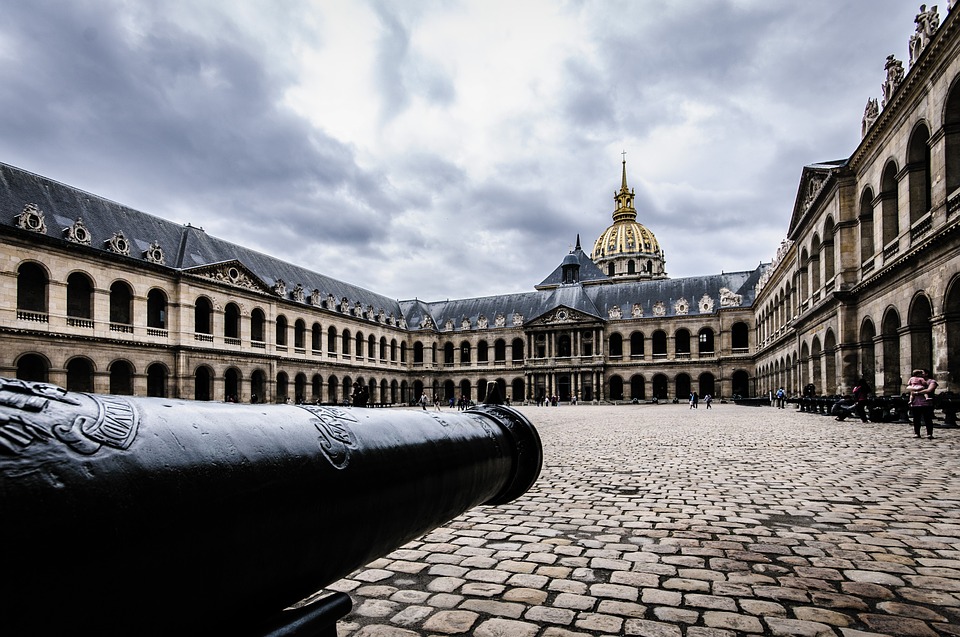A Trip to Paris: Visiting the French Capital’s Most Famous Attractions (Part 6) Posted by mtaulier on Nov 30, 2013 in Culture
If you’ve been reading this series from the beginning, you’ll notice that we’ve already covered les sites les plus connus de Paris (Paris’s most famous sights). We will now be taking the time to visit (virtuellement, bien sûr) some of the more obscure and lesser-known sights. You may not be familiar with these, but they are well worth a visit, especially if you have reserved a couple days to roam around the city.

Today, we will be exploring le Musée de l’Armée (the Army Museum), also known as l’Hôtel National des Invalides (National Residence of the Invalids). Located near the Eiffel Tower and just across the Seine River from the Champs Elysées, this building complex comprises both museums and monuments dedicated to l’histoire militaire de la France (France’s military history). For well over a thousand years, the French have been refining l’art de la guerre (the art of war) and les Invalides offers a vivid portrayal of the development of their martial prowess over time. If you have no interest in military history, don’t cross les Invalides off your list so quickly. Despite its military focus, the museum also offers a variety of classical music concerts and film screenings all within a grandiose 17th century setting. Les Invalides is also within walking distance of some more popular monuments so it is well worth a stop, even if you’re just on your way to visit something else.
King Louis XIV (the same Louis we met in our last post about Versailles) had l’Hôtel des Invalides built as a hospital for wounded soldiers in 1670. In the early 19th century, Emperor Napoleon I made visits to the hospital to check in on his soldiers. This brings us to perhaps the most important aspect of les Invalides. It has been the resting place of Emperor Napoleon I since 1861. His imposing sarcophage (sarcophagus), made of red porphyry, can be visited in the circular crypt. Napoleon I is one of France’s great national treasures, not to mention one of the greatest military minds in all of history. This tomb is larger than life and befits such a towering figure, one who believed le pape (the pope) unworthy to crown him emperor and so took la couronne (the crown) in his own hands and placed it on his head.
Seated upon a pedestal made of granit vert (green granite), the sarcophagus contains six coffins. From smallest to largest, they are made of oak, ebony, two of lead, mahogany and finally soft iron. Douze statues de la déesse Grecque Victoire (Twelve statues of the Greek goddess Victory) surround the sarcophagus while off to the side, in a glass case you can see original wool coat and hat Napoleon is most famous for.
Once you are finished visiting the emperor’s tomb, feel free to roam the grounds and take photos of the beautiful 17th-18th century architecture and then proceed to the museum. Offering a stunning panoply of armes, armures (weapons, armor) and other military paraphernalia, le Musée de l’Armée is second to none. If you are a military history aficionado, the museum is a must-see. The exhibits cover a wide range of weapons and armor spanning several cultures and centuries (13th-17th). Along with a vast array of traditional western European examples, you will also see splendid pieces belonging to the Japanese Samurai. You will see the intricate ceremonial armor worn by the kings of France and you will get a glimpse of what it must have been like to face a knight in full armor riding atop his armored steed sur un champ de bataille au Moyen Âge (on a battle field in the Middle Ages). The advent of la poudre à canon et les armes à feu (gunpowder and firearms) is well represented by a broad selection of canon, rifles, handguns and the like, again spanning several centuries of warfare up until the end of World War II.
The museum is open sept jours par semaine (seven days a week) except for holidays. Individual prices are €9.5 which includes access to the museum, the emperor’s tomb, the Charles de Gaulle monument and more. There is a book and gift shop as well as a cafeteria. The multimedia guide for iPod Touch costs €6, is made available in several languages, and will act as your “digital guide” throughout your visit.
While still a very famous landmark, the Invalides is often overshadowed by more popular Parisian attractions such as La Tour Eiffel, l’Arc de Triomphe and Le Louvre. But should you choose to dedicate a day to visiting these more renowned monuments, why not take a couple hours and visit les Invalides? It is ideally located between La Tour Eiffel and l’Arc de Triomphe or Le Louvre and is easily accessible by Métro (subway). Even if you don’t like military history, you can still brag to your friends and family that you stood in the presence of an emperor and, well, how many people can say they’ve done that?

Build vocabulary, practice pronunciation, and more with Transparent Language Online. Available anytime, anywhere, on any device.



